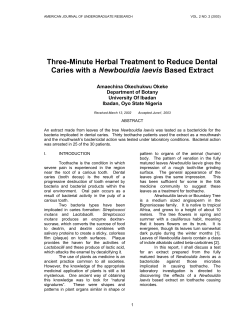
Practice 02B Culture [Kompatibilitási mód]
Culturing of bacteria The aims are: To make pure cultures of pathogen bacteria. To make isolated bacterial colonies on solid medium for further investigation and identification of bacteria. Culturing of bacteria Requirements for growth: Nutrients: e.g., salts, carbon-source, nitrogen-source, proteins, vitamins, organic growth factors Water Presence or absence of oxygen – obligate aerobes, facultative anaerobes, obligate anaerobes, microaerophils and aerotolerant anaerobes Temperature (mesophils) pH 6.5-7.5 Culturing: A. Natural media: milk, bile, potato B. Complex media 1. Liquid media 2. Semi-solid media 3. Solid media 1. Liquid media Peptone water distilled water, NaCl, peptone examination of bacterial biochemical activity Broth (bouillon): meat soup enrichment medium or biochemical examination solidified bouillon – nutrient agar 2. Semi-solid media Motility examination: Medium is made from bouillon (0.5% agar) Positive: determined by turbidity in semi-solid media E. coli, E. cloaceae, P. aeruginosa Non motile: demonstrated by growth only in the site of inoculation S. sonnei, K. pneumoniae Bouillon with meat: with meat, liver, brain etc. if is boiled and paraffin-covered, anaerobe environment can be done enrichment medium, maintain the culture of a bacteria 3. Solid media Simple media: agar is a polymer made up of subunits of the sugar galactose. Agar polysaccharides serve as the primary structural support for the algae's cell walls. Nutrient agar (pigment production) Blood agar with 5 % native (defibrinated) cattle or sheep blood. Hemolysis can be seen on it. Chocolate agar is done with boiled blood. Mainly in case of fastidious bacteria (e.g. Haemophylus). Contains some growth factors (NAD, hemin). Hemolysis α-hemolysis: incomplete (partial) hemolysis. greenish colour around the colonies on the medium (blood agar, chocolate agar). red blood cells don’t break down, haemoglobin decomposed into greenish compound (biliverdin). Streptococcus pneumoniae. β-hemolysis: complete hemolysis. colourless area around the colonies on the blood agar, not on the chocolate. red blood cells break down, haemoglobin fully decomposed can not be investigated on chocolate agar (absence of intact RBC) Staphylococcus aureus, Streptococcus pyogenes 1 3. Solid media Selective media: inhibition of unwanted microbes with salts, dyes or other chemicals allow growth only of the desired bacteria TCBS: Vibrio cholerae E67: Enterococcus faecalis has dark blue/black colonies Löwenstein-Jensen (slent) agar: Mycobacteria; malachite green is responsible for selectivity. 3. Solid media Differential media: Differential media include an indicator that cause visible, easily detectable changes in the appearance of the agar gel or bacterial colonies. Eosin-methylene blue agar: to distinguish species of Enterobacteriaceae family on the basis of lactose fermentation, only for Gram negatives. Lactose + : blue/pink (E.coli, Klebsiella) Lactose - : colourless (Proteus, Shigella, Salmonella) MacConkey agar for Gram-negatives lactose fermentation 3. Solid media Selective-differential media: for isolation and differentiation of enteric pathogens Brillant green agar: lactose, fuchsine, brillant green: inhibit growing of E. coli and swarming of Proteus. Salmonella and Shigella have colourless colonies. Bismuth-sulphite agar: glucose, Na-bisulphite, Bi-sulphate, brillant green. Salmonella has black colonies because of Bi-salt. Deoxycholate-citrate agar: Lactose, Na-citrate, Na-dezoxicholate, Pb-acetate, neutral red indicator. E. coli: red colonies because of lactose fermentation, Salmonella and Proteus: brown colonies because of H2S production (Pbsulphide), Shigella has colourless colonies. Clauberg-agar: K-tellurit, cysteine. Difference between the three colony types of Corynebacterium diphtheriae. Gravis, mitis, intermedius. XLD agar xylose lysine deoxycholate agar Salmonella, Shigella 3. Solid media Anaerobic culture Physical: in the anaerostat: air is removed and CO2 and N2 Special media: for fastidious bacteria Löffler medium: Corynebacterium diphtheriae. Bordet-Gengou agar: Bordetella pertussis. Francis agar: Francisella tularensis. CYE agar: Legionella pneumophila. Synthetical media: Citrate media: to distinguish E. coli (-) and Klebsiella (+). gases are added. Chemical: Alcalic pyrogallol: pyrogallic acid and NaCO3 are added, which binds oxygen, and Petri dish is closed. Organ bouillons: bouillon is made with meat, liver, brain, is boiled and paraffin is added, and so closed from oxygen. Thioglycolate medium: sodium-thioglycolate is added, which decreases redox-potential. Biological: Fortner-method: there is a strong O2 user bacteria (Serratia marcescens) on the half of the medium, too, near the anaerobe. 2 Macroscopic morphology of bacterial colonies Shape Edge Elevation Surface Opacity (e.g. transparent (clear), opaque, translucent (almost clear), iridescent (changing colours in reflected light). Pigment production (e.g. white, green, red, purple, yellow) 3
© Copyright 2025









